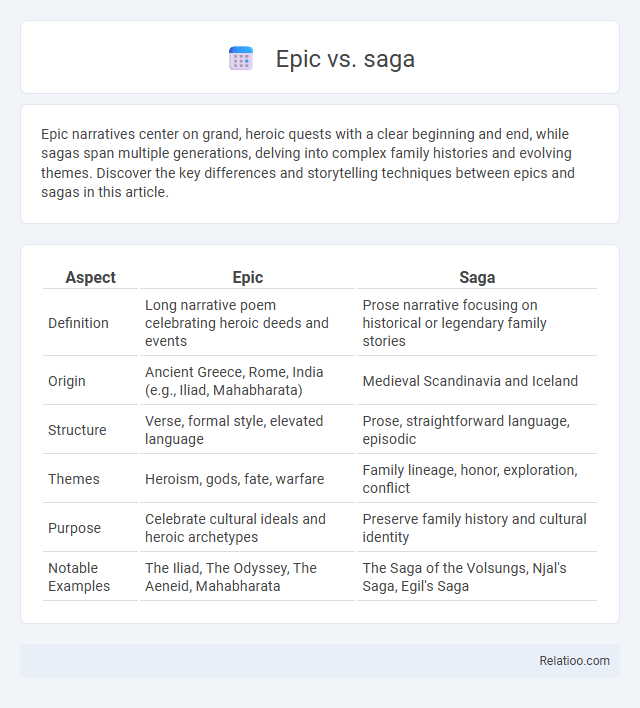Epic narratives center on grand, heroic quests with a clear beginning and end, while sagas span multiple generations, delving into complex family histories and evolving themes. Discover the key differences and storytelling techniques between epics and sagas in this article.
Table of Comparison
| Aspect | Epic | Saga |
|---|---|---|
| Definition | Long narrative poem celebrating heroic deeds and events | Prose narrative focusing on historical or legendary family stories |
| Origin | Ancient Greece, Rome, India (e.g., Iliad, Mahabharata) | Medieval Scandinavia and Iceland |
| Structure | Verse, formal style, elevated language | Prose, straightforward language, episodic |
| Themes | Heroism, gods, fate, warfare | Family lineage, honor, exploration, conflict |
| Purpose | Celebrate cultural ideals and heroic archetypes | Preserve family history and cultural identity |
| Notable Examples | The Iliad, The Odyssey, The Aeneid, Mahabharata | The Saga of the Volsungs, Njal's Saga, Egil's Saga |
Defining Epic and Saga
An epic is a long narrative poem or story centered on heroic deeds and grand adventures, often involving gods and supernatural elements, highlighting the cultural values of a society. A saga tends to be a lengthy prose narrative that chronicles family histories or legendary heroes over multiple generations, typically rooted in Scandinavian or Icelandic traditions. Understanding how your storytelling fits into either an epic or a saga helps clarify the scope and depth of your narrative ambitions.
Historical Origins and Evolution
Epics originated as long narrative poems rooted in ancient oral traditions, often recounting heroic deeds and cultural myths in civilizations such as Mesopotamia and Greece. Sagas, emerging primarily from medieval Iceland and Scandinavia, evolved as prose narratives emphasizing family histories and legendary events within Norse culture. Storytelling, a broader and more adaptive practice, spans global cultures and mediums, continuously evolving from oral recitations to written and digital formats while preserving the human impulse to convey experiences and values.
Structural Differences
Epics typically consist of lengthy narratives centered around heroic deeds and grand themes, often structured in multiple cantos or books, emphasizing a formal, elevated style. Sagas are prose narratives originating from Norse culture, focusing on genealogy and historical events, with episodic and chronological structures that highlight family and cultural legacy. Storytelling, in a broader sense, encompasses various formats and structures, prioritizing the progression of plot and character development through acts or chapters tailored to the narrative's purpose and audience engagement.
Narrative Scope and Scale
Epic narratives encompass vast settings and long timeframes, often involving heroic quests and grand conflicts that shape entire worlds or civilizations. Sagas focus on multi-generational family histories or heroic deeds, blending personal and communal struggles with a broader cultural legacy. Your storytelling choices depend on desired narrative depth and scale, whether crafting expansive epics, detailed sagas, or more contained stories with focused emotional arcs.
Themes and Motifs
Epic narratives emphasize grand themes of heroism, fate, and the struggle between good and evil, often using motifs like quests, battles, and supernatural interventions to reinforce their scale and importance. Sagas highlight cultural identity, lineage, and historical legacy, featuring motifs such as family feuds, honor, and survival, which underscore communal values and ancestral pride. Storytelling broadly encompasses diverse themes ranging from personal growth to moral dilemmas, utilizing motifs like transformation, conflict, and redemption to engage audiences across various contexts.
Key Examples in Literature
Epic literature features grand narratives like Homer's "Iliad," showcasing heroic deeds and cultural values on a vast scale, while sagas, such as the Icelandic "Njals Saga," emphasize familial struggles and historical events within a specific cultural context. Storytelling broadly encompasses both forms but also includes diverse narrative techniques found in works like Gabriel Garcia Marquez's "One Hundred Years of Solitude," which blends magic realism with intricate character development. Your understanding of these genres deepens by analyzing how epics convey timeless heroism, sagas preserve historical legacy, and storytelling adapts to varied cultural expressions.
Cultural Significance and Influence
Epics, sagas, and storytelling each hold profound cultural significance, shaping collective identities and preserving historical values across generations. Epics, often grand narratives like Homer's Iliad, symbolize foundational myths and heroic ideals central to a culture's worldview. Sagas, particularly in Norse tradition, blend historical record and legend to influence cultural continuity, while storytelling operates as a dynamic tool that adapts and transmits cultural norms, morals, and communal wisdom.
Characterization and Heroism
Epic narratives emphasize grand-scale heroism and often portray larger-than-life protagonists whose characterization is archetypal, embodying universal ideals and virtues. Sagas blend historical and familial elements, providing deeper character development that highlights personal struggles and evolving heroism across generations. Storytelling, in a broader sense, allows for nuanced character arcs and diverse expressions of heroism, focusing on individual growth and moral complexity rather than solely on epic feats or lineage.
Oral Tradition vs Written Tradition
Epic narratives originate primarily from oral traditions, characterized by grand, lengthy tales often composed through oral performance and passed down generations before being written. Sagas, while also rooted in oral storytelling, especially in Norse and Icelandic cultures, exhibit a more localized and historical focus, bridging oral practices with early written records. Storytelling as a broader concept encompasses both oral and written traditions, serving as the vehicle for cultural transmission, but written storytelling allows for greater preservation, complexity, and dissemination of narratives beyond their initial oral contexts.
Modern Adaptations and Legacy
Modern adaptations of epic, saga, and storytelling blend traditional narratives with contemporary themes, enhancing cultural relevance and audience engagement. Epics often inspire blockbuster films and video games by emphasizing grand, heroic journeys, while sagas are adapted into serialized TV shows and podcasts that explore complex family legacies. Your understanding of storytelling's legacy deepens when you recognize how these formats preserve ancient morals while embracing innovation to resonate with today's diverse audiences.

Infographic: Epic vs Saga
 relatioo.com
relatioo.com